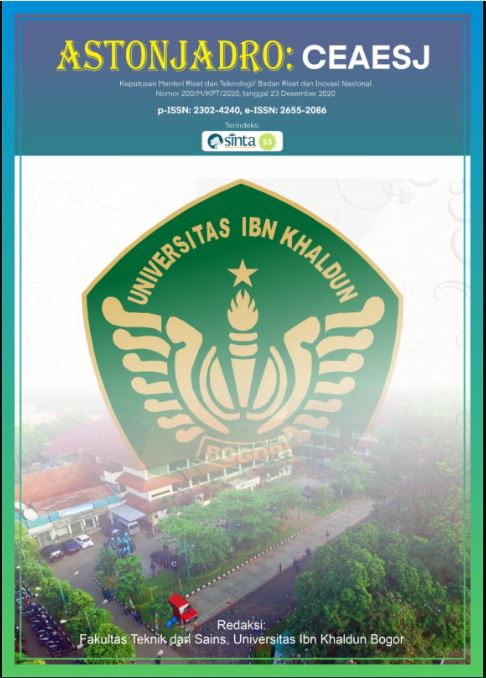DETERMINATION OF CARBON EMISSIONS WITH A GREEN MANUFACTURING APPROACH
DOI:
https://doi.org/10.32832/astonjadro.v11i2.6690Keywords:
green manufacturing, emission, UMKM, meatball, environmental, manufacturing.Abstract
A green manufacturing approach on production of bakso aci will give contribution for UMKM in process to find out the origins of environmental waste. This research has purposed to identify the origins and type of environmental waste in production process of bakso aci sekar at UMKM Sekar Group Bogor. The method used for this research are calculation with mass-balance and the emission with calculator carbon footprint. The data collecting process is carried out by observation and interview with the related person in UMKM Sekar Group Bogor. The waste identify results has show that environmental waste were found on production of bakso aci sekar. The results of show that environmental waste generated are CO2 Emission with a total of 0.18049 tons, water with a total of 10.5 Liters, material with a total of 0.482 Kg, and waste with a total of 0.5184 Kg. The identification of environmental waste with a green manufacturing approach will provide information for UMKM Sekar Group Bogor on process to find out the origins of environmental waste on their production process.
References
Anas, M. Fauzi; Ainy, Rahmawakhida; Yaoi, H. 2008. Kajian Strategi Produksi Bersih di Industri Kecil Tapioka: Kasus Kelurahan Ciluar, Kecamatan Bogor Utara. Jurnal Teknologi Industri Pertanian, 18(2), 60–65. (Indonesian).
Amrullah, S., Kholis, M. N., & Luketsi, W. P. 2018. Potensi Penerapan Produksi Bersih Pada Industri Roti Di Ponorogo. Journal of Agroindustrial Technology, 2(2), 130. (Indonesian).
Badan Pusat Statistik. 2019. Jumlah Perusahaan Industri Mikro dan Kecil Menurut Provinsi. Badan Pusat Statistik. https://www.bps.go.id/site/resultTab (Diakses pada 4 November 2021 pukul 12.43). (Indonesian).
Deif, A. M. 2011. A System Model For Green Manufacturing. Journal of Cleaner Production, 19(14), 1553–1559.
Haines, F., and Reichman, N., 2008.The Problem That Is Global Warming: Introduction, LAW & POLICY, Vol. 30, No. 4.
Halim A., 2020. Pengaruh Pertumbuhan Usaha Mikro, Kecil Dan Menengah Terhadap Pertumbuhan Ekonomi Kabupaten Mamuju, GROWTH: Jurnal Ilmiah Ekonomi Pembangunan, Volume 1, No. 2. (Indonesian).
Indrasti, N. dan Fauzi, A., Produksi Bersih, IPB Press, 2009. (Indonesian).
Jaya, J. D., Ariyani, L., & Hadijah, H. 2019. Designing Clean Production of Tofu Processing Industry in Ud. Sumber Urip Pelaihari. Jurnal Agroindustri, 8(2), 105–112.
Kaczmarek M.J., Antosz K., Gola A., 2021. From Lean to Sustainable Manufacturing – An Overview, European Research Studies Journal, Volume XXIV, Special Issue 2
Nurseto S., 2012. Analisis Pengaruh Lingkungan Industri Terhadap Strategi pemasaran dan Dampaknya Terhadap Kinerja perusahaan: Studi pada Usaha Kecil Kerajinan Kulit Tanggulangin, Jurnal Administrasi Bisnis Volume I Nomor 1. (Indonesian).
Priscilia. 2017. Analisis Produktivitas Kerja Pada PT Berkat Anugerah Jaya. Jurnal AGORA, 5(1), 1–6. (Indonesian).
Rimantho D., and Ardinia D., 2020. Selection strategy implementation of cleaner production using ISM and AHP Method in Chemical Laboratory of Service Industries, IOP Conf. Series: Materials Science and Engineering 847, 012004
Rimantho D., Athiyah, 2019. Analisis Kapabilitas Proses Untuk Pengendalian Kualitas Air Limbah Di Industri Farmasi, Jurnal Teknologi, Volume 11 No.1. (Indonesian).
Rimantho D., dan Rosdiana H., 2017. Penentuan Faktor Kunci Peningkatan Kualitas Air Limbah Industri Makanan Menggunakan Interpretative Structural Modeling (ISM), Jurnal Ilmu Lingkungan, Volume 15, Issue 2 :90-95. (Indonesian).
Riphah U.S. 2015. Global Warming: Causes, Effects and Solutions, Durreesamin Journal, Vol 1; Issue 4.
Rinawati, D. I., Sari, D. P., W.P., S. N., Muljadi, F., & Lestari, S. P. 2013. Pengelolaan Produksi Menggunakan Pendekatan Lean and Green Untuk Menuju Industri Batik Yang Berkelanjutan (Studi Kasus Di UKM Batik Puspa Kencana). Jurnal Teknik Industri, 8(1), 43–50. (Indonesian).
Tanael, E. D., Sumarah, N., & Ayodya, B. P. 2021. Efek Penggunaan Instagram Dalam Rebranding Produk Umkm Baso Aci Akang (The Effects Of Using Instagram In Rebranding Of Baso Aci Akang As An UMKM Products). 1–9. (Indonesian).
Widodo, L. 2017. Potensi Penerapan Konsep Produksi Bersih Pada Industri Keramik di Probolinggo. Jurnal Teknologi Lingkungan, 18(2), 192. (Indonesian).
Downloads
Published
How to Cite
Issue
Section
License
Paper submitted to ASTONJADRO is the sole property of the Astonjadro Journal. Unless the author withdraws the paper because he does not want to be published in this journal. The publication rights are in the journal Astonjadro.ASTONJADRO
LICENSE
This work is licensed under a Creative Commons Attribution-ShareAlike 4.0 International License.
Based on a work at http://ejournal.uika-bogor.ac.id/index.php/ASTONJADRO













